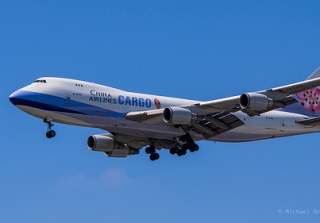 The freighter fleet at Asia’s major airlines is largely unchanged at 135 aircraft in 2013, down from 2012’s peak of 148 aircraft, but up from the 133 in 2006, reflective of a regional air cargo industry that’s in a rut, according to a new report from the CAPA Centre for Aviation.
The freighter fleet at Asia’s major airlines is largely unchanged at 135 aircraft in 2013, down from 2012’s peak of 148 aircraft, but up from the 133 in 2006, reflective of a regional air cargo industry that’s in a rut, according to a new report from the CAPA Centre for Aviation.
Korean Air, China Eastern, and Cathay Pacific have made the largest net additions, while EVA Air and Singapore Airlines are alone in making net decreases.
The report from the Sydney-based aviation market and data analysis provider focused on Asia’s eight main airlines with widebody aircraft that report statistics on their fleet, which also included Air China, Asiana, and China Airlines.
EVA Air has shrunk its fleet from 24 freighters in 2006 (when it was then the largest by aircraft fleet size) to 17 in 2013, making it the fourth largest, said the report.
EVA Air reportedly plans to further decrease its dedicated freighters to less than 10 by 2017 as it retires its MD-11Fs.
Cathay Pacific and Korean Air grew to have the largest number of freighters in 2013, while Singapore Airlines (SIA) decreased its cargo fleet from 14 in 2006 to nine at the end of fiscal year (FY) 2013.
By the end of the first quarter of its FY2014, SIA had further reduced its freighter fleet to eight.
Cathay around 2011 had planned for upwards of 38 freighter aircraft in 2017, but is now looking at a figure closer to 20.
Between the freight aircraft peak in 2012 and 2013, five airlines reduced their number of freighters, while three (Asiana, China Airlines, and Cathay) kept their fleet flat. China Eastern made the largest change by withdrawing a net total of five aircraft, comprising its three remaining MD-11Fs and two of its last three A300Fs.
From 2006 to 2013, five airlines made net additions to their freight fleet while two made decreases (EVA Air and Singapore Airlines) and one kept its fleet flat (Air China).
Of eight airlines studied, four had lower freight capacity in 2013 than 2012.
The sheer aircraft numbers mask lowered productivity, generally weakened load factors and yields competition from outside the region, and growing bellyhold capacity, said the paper.
Freighter trails behind passenger fleet growth
It likewise noted the small growth in freight compared with passenger aircraft growth.
“The weakness of the cargo segment is especially evident when contrasting the growth of net freight aircraft to net passenger growth. Of the airlines in this study, all but Korean Air saw faster passenger aircraft growth than freight aircraft growth.”
To respond to the weaker freight environment, some airlines have reduced their freighter fleet, while others are pinning hopes on efficiency improvements to lift them out of the rut by using newer and more efficient aircraft, such as 777Fs and 747-8Fs, thereby reducing operating expenses.
CAPA also observed how the big airlines are now flying less cargo, and the small airlines are flying more.
The four largest freight carriers in 2006 in terms of freight tonne kilometers—Korean Air, Singapore Airlines, Cathay Pacific, and China Airlines—carried less cargo in 2013 than they did in 2006.
Meanwhile, the four smallest carriers in 2006—EVA Air, Air China, Asiana, and China Eastern—carried more cargo in 2013 than they did in 2006, with EVA Air seeing the largest growth.
The report continued: “It is worthwhile to note the two mainland Chinese carriers in this study are seeing growth while network freight carriers (which had been relying on China) are suffering decreases, suggesting Chinese carriers are capturing back traffic that otherwise went via other countries.”
As for freight yields, the paper said yields in 2013 were lower than in 2006, except for Asiana and Cathay.
“Financial results of air freight are limited; only Singapore Airlines discloses a profit/loss (the latter more common as of late) for its freight division. But yields can be an indicator, with a survey of indexed performance showing carriers posting weaker yields in 2013 than in 2006. Exceptions are Asiana and Cathay Pacific. However, it should be recalled Asiana’s load factor has weakened and Cathay’s drastically so, suggesting the two are trading load factor for yield.”
Utilization on a downtrend
Moreover, while the number of freighter aircraft in Asia may show little change, utilization of those aircraft is down, further adding to load factor and yield challenges.
For most airlines, only anecdotal evidence is available. Asiana and Cathay however provide statistics, Asiana for all of its freight aircraft and Cathay for only its active 747 models. “Both show a constant decline in utilization with a blip during the brief 2010 upturn,” said CAPA.
Noting how the operating environment has been changing, the report said the industry’s woes are “sometimes self-inflicted, from delayed responses to passenger aircraft growth cannibalizing cargo markets.”
Cathay, for example, has ended regular Manchester freighter service in advance of forthcoming passenger flights to Manchester. At European carriers this is taken to the extreme, with Air France-KLM reporting in July 2014 that dedicated freighters accounted for only 28 percent of group freight capacity in 2013, down from 53 percent in 2008/2009.
CAPA continued: “Improvements have been needed all round. After stagnation to see if a recovery would occur, airlines have (begrudgingly—after all this was a nice cash cow at its peak) accepted a changed environment, one that will look different if and when a recovery emerges. There have been responses, but more improvements still to be made. It is difficult to accept a changed market and be willing to make one of the early moves.”
Photo: Michael @ NW Lens




